The problem with people.
When you were young, did you ever hear the mantra “always treat other people how you’d wish to be treated”?
This is great advice when it comes to ethics – but very poor advice when it comes to communication.
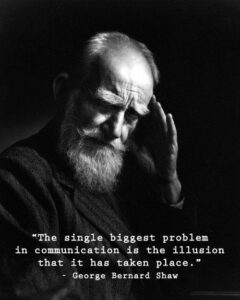
Whether you’re selling an idea, a product or responsibility for a doing something, the other side must be a willing buyer or the transaction falls flat. They have to ‘get it’. You need to be speaking their language.
And in a nutshell this is where it’s easy to go wrong as an employer.
Because the right approach for one will clash with another.
Some people are natural optimists and tend to get excited about new things straight off the bat. Whereas others are hard-wired to be cautious and will immediately see the snags.
For every person who likes to figure stuff out for themselves there’s another who wants support as they learn how to do it.
Take any group of 10 people and you’ll likely find at least 2-3 who will get bored if they consistently achieve their targets and 2-3 who will get seriously disheartened when they miss one.
There’s no right or wrong to this, it’s just the way we’re wired up.
But, if you treat everyone how you’d wish to be treated, you will be grinding the gears of at least 25% of your team and getting a patchy response from 50%.
The listener won’t be able to hear what you’re saying because of how you’re saying it.
So how can we tell one from another?
The first step is to get a clear, simple framework to help work out who’s who.
Psychometric profiles have been around for over 100 years. Originally, they were thought to be valuable as a predictor of academic results. This turned out to very much not be the case, and they fell into disuse.
Then in the 1960s they some bright spark started using them to help boards of directors communicate with each other more effectively. This was valuable and the use of psychometric profiles proliferated.
You now have a choice of 20 or so. These vary according to the length of the questionnaire, the terminology used and the intricacy of conclusions that are gleaned from the questionnaires.
What they share in common is the chassis they are based on. A series of nuanced psychological questions with a set of answers. You then select which of the answers fits you best and least. And the picture of you – the patterns of your behaviour – emerges.
The one I use (DISC) has been around for a fair while and is probably amongst the more ‘basic’ available. Some people look down on it for this, favouring newer, shinier options with more intricate reports.
My view is simple: the more bells and whistles a psychometric profile has, the more chance the big lessons will be obscured, and the value left unrealised.
DISC is valuable because the lessons hit you in the face. In a nice way.
Understanding the basics of DISC
DISC separates people into 4 behavioural types by categorising people on either side of 2 dividing lines – giving you 4 main categories. Your report will then highlight the 1 or 2 of these 4 categories that most represent you – most of the time.
The first line determines if you are Outgoing or Reserved.
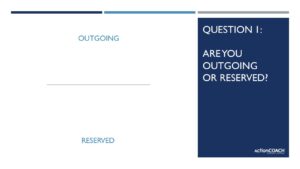 Outgoing people are naturally assertive and tend to say more and at a faster pace. They are in a sense ‘set to transmit rather than to receive’. With that, they are decisive and tend to make decisions more easily and faster. They are more motivated by winning than they are deterred by getting things wrong. As such, they’re willing to change their minds. And do – frequently.
Outgoing people are naturally assertive and tend to say more and at a faster pace. They are in a sense ‘set to transmit rather than to receive’. With that, they are decisive and tend to make decisions more easily and faster. They are more motivated by winning than they are deterred by getting things wrong. As such, they’re willing to change their minds. And do – frequently.
Reserved people weigh their words and their decisions carefully. They really don’t like to get things wrong and are risk averse. If you’re in the Outgoing category and have a zoom call with someone in the Reserved category you may well think they’ve ‘frozen’ when in fact they’re just deciding how to respond.
Reserved people tend to believe the world works better when we all stick to the rules whereas Outgoing people tend to view rules as being useful for other people – but mere guidelines for themselves.
Quick Question to self-diagnose: Are you decisive? (If you’re not sure, the answer is ‘no’.)
The second line determines if you are Task focussed or People focussed.
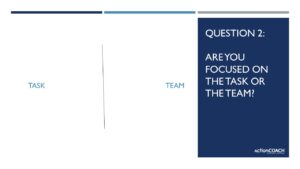
Task focussed people are willing to priortise ‘getting the job done’ above the feelings of others.
They’d be most likely to agree to the statement that “people in general are too sensitive” and believe that treading on a few toes or ruffling a few feathers shouldn’t be a barrier to achieving a successful outcome.
They are relatively Guarded as a communication style. In other words, they’ll do their thinking internally and probably on their own.
Team orientated people like to collaborate. They prefer to discuss thoughts and challenges with other people. If pushed, they would prioritise the well-being of the team above results.
They are relative Open in their communication style and are happy to share their thoughts and feelings.
Quick Question to self-diagnose: Do you frequently worry about the feelings of others in a business context? (if you’re debating the word ‘frequently’ the answer is probably ‘yes’)
Overlay those two lines, and you get the 4 behavioural types of DiSC.
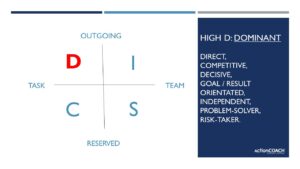 High D: Dominance
High D: Dominance
Direct, competitive, decisive, goal / result orientated, independent, problem-solver, risk-taker.
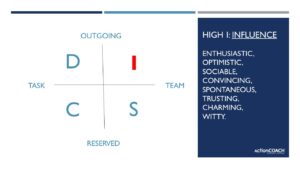 High I: Influence
High I: Influence
Enthusiastic, optimistic, sociable, convincing, spontaneous, trusting, charming, witty.
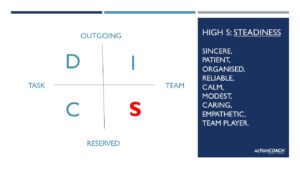 High S: Steadiness
High S: Steadiness
Sincere, patient, organised, reliable, calm, modest, caring, empathetic, team player.
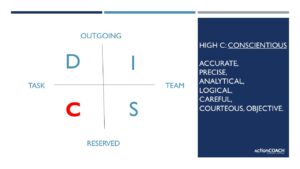 High C: Conscientious
High C: Conscientious
Accurate, precise, analytical, logical, careful, courteous, objective.
Quick question to self-diagnose: which 2 of the above sets of words fit you best – at work – most of the time?
The unavoidable consequence of being something / anything.
You may have a personal preference as to which group you’d like to be in. But you can’t say that any of the groupings are bad.
There are, however, unavoidable (negative) consequences of your behavioural patterns.
To understand these, imagine yourself under pressure and as seen from the perspective of someone who is in the quadrant diagonally opposite from the one you occupy most.
How does the undiluted ‘High D’ come across to a ‘High S’?
Your natural High D inner drive and willingness to tackle things yourself comes across to them as selfish and arrogant. Your certainty of decision-making and actions comes across as domineering or bullying. The High D’s leaning towards internal decision-making leaves others playing catch-up and feeling like pawns in someone else’s game.
How does the undiluted ‘High I’ come across to a ‘High C’?
To someone who is careful and precise, a High I’s big, optimistic vision will come across as grandiose, unrealistic and woolly. While you think you are rallying the troops a High C will just see a bit of a peacock – a show off. Your (ahem) spontaneous decision-making comes across as risky and chaotic.
How does the undiluted ‘High S’ come across to a ‘High D’?
Your qualities of being calm and considerate to others, will come across as slow and weak to a High D. As you pause to consider something from someone else’s perspective, the High D will be screaming (hopefully just internally) “Just get on with it!!”. Modesty and humility will be seen as diffidence.
How does the undiluted ‘High C’ come across to a ‘High I’?
Whilst you’re trying to help by pointing out the errors in the analysis, gaps in the plan and pitfalls of the proposed solutions, the High I just sees you as picky, pessimistic and stuck-in-the-mud. Always letting perfectionism get in the way of progress. Refusing to change things up or innovate. While you prefer not to be intrusive and ask about personal lives, they see you as cold and remote.
The 3 BIG lessons of DISC
This leads us to the big 3 lessons to be taken from DiSC in any sphere of communication.
- When you’re communicating with people who are diagonally opposite from you, either meet them halfway or don’t expect it to be easy.
- Differences in communication styles are magnified under pressure as everyone retrenches further into their corners.
- Your strengths, when left unchecked, become your weaknesses.
A word on using DISC in teams.
I was asked to run a DISC session with a group of 60 or so trainee teachers.
As luck would have it there was a very even spread of Ds, Is, Ss and Cs.
The workshop finished with a ‘simple’ exercise. Having split the group into their DISC quadrants, I gave each a flip chart and 20 minutes to plan a ‘reward trip’ for students. On your marks, get set, GO!
The Conscientious Group immediately started asking for details about the budget.
The Steadiness Group were concerned about the criteria for who was allowed on the day. Who would miss out and how would that be handled?
Within 10 minutes the Dominance Group had finished with about 7 bullet points in total. “Departure 10am, back by 4pm” type of thing. No mention of why it would be seen by the kids as a reward, what to wear, special dietary needs, etc.
The Influence Group finished next with a plan that was broad-brush but sounded like it’d be fun.
The Steadiness Group had yet to put pen to paper and were still discussing aspects of the day and how it would ‘land’ with the students. Aspects that the D & I Groups had not even considered.
The Conscientious Group had completed about 10% of their plan – in intricate detail.
In this instance, and when I’ve done similar exercises with teams in various businesses, all the groups said how much they enjoyed working together. With everyone looking at things the same way and no one pointing out the blind spots in their approach. How very harmonious!
So which group is best to tackle business challenges?
The answer to this depends on how you define the term ‘best’. Based on the example above some would no doubt argue the answer is either Dominants or Influencers.
You might argue for either Conscientious or Steadiness types – albeit if they were given more time.
Certainly, if you’ve got a business idea and you want someone to get it off the ground for you in the fastest possible time, ask a High D. There’ll be a fair amount of broken crockery, but it’ll be off the ground.
If you term the best as having the highest possible chances of success and engaging the team in that success; I’d argue the correct answer is “all of them – together”.
They all paint part of the picture but none of them captures the entire vision.
The best teams will have a healthy balance of all 4. In an environment where strengths are utilised, and weaknesses are limited.
The Platinum Rule of Communicating… anything.
I hope I’ve managed to demonstrate why ‘always treating other people how you would want to be treated’ is almost guaranteed to backfire when it comes to communication.
Depending on the balance of your team, you’ll likely click with 25%, clash with 25% and muddle through with the rest.
You may well (depending on your approach and industry) have a team that favours one side of the DISC quadrant. Although whilst people often tell me this is the case, it frequently turns out to not be the case.
Either way, the real Platinum Rule for Communication will stand you in good stead:
Always treat other people how they would want to be treated.
Want to explore using this yourself and with your teams?
I love running these workshops – sometimes in a sales context, sometimes for managers and also for getting mixed teams together and working better.
They’re different each time because the businesses and the people are different.
If you’d like to discuss this for yourself and your team, please do book in for a call.
Click here for more articles by Tim Brown
NB: A word for the sceptics.
Some people give these tests a hard time, describing them as a pseudo-science.
That may be true in one sense. DISC is based on a relatively short list of 28 questions where you pick a ‘most like me’ and a ‘least like me’ from 4 possible options. Not a lot of ‘science’ in there.
But what is undeniable (having done 200 or so of these over the years) is how accurate they are at giving an indication of approach and communication style.
These often lead to lightbulb moments which when acted upon can create huge value.
DISC is a simple, broad-brush tool. It’s best used as one method of helping you understand your approach and that of others. When used in this context and in conjunction with your own good judgement, it is brilliant and valuable.
If you over-egg it and view it as some sort of ‘all-seeing-eye’, or as a stick to hit people with, you (and it) will come unstuck.





